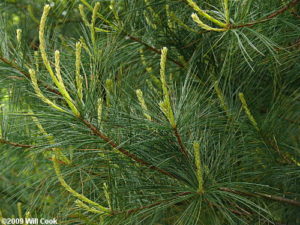Eastern White Pine is for the Birds
 The eastern white pine, Pinus strobus, is one of the most popular native plants in our region. And even though these trees are commonly used in both public and private gardens, there are still many reasons why you should consider adding these lovely trees to your landscape. One of the principal reasons is that the eastern white pine is really ‘for the birds’.
The eastern white pine, Pinus strobus, is one of the most popular native plants in our region. And even though these trees are commonly used in both public and private gardens, there are still many reasons why you should consider adding these lovely trees to your landscape. One of the principal reasons is that the eastern white pine is really ‘for the birds’.
Historically, white pines were considered to be valuable for their straight trunks and soft wood. Eastern white pines were favored over all other timber to be used as masts for British sailboats. During colonial times, the British Royal Navy used to mark white pines with a broad arrow in order to reserve them to be logged for the masts of navy boats. White pines were so beloved by the King of England that he had long ships built specifically for the transport of these pine trunks across the ocean into England. White pines continue to be prized for their use in furniture, flooring, and paneling, because eastern white pines are knot-free, easy to cut, and easy to grow.
As a garden plant, white pine is no less a treasure for your landscape. White pines give a soft look to the garden and because they are evergreen, they give color and form during the gray winter months when little else is discernible against the barren landscape. The wispy long needles, always growing in sets of five, create a texture that is at once delicate and billowy but at the same time dense and solid.
Uses of the white pine for the landscape are numerous and indispensable. Besides giving structure and color in the winter, the evergreens fulfill many other functions. White pines can be successfully used as windbreaks, as hedges to screen an unattractive view, or as living fences. Electric companies recommend planting evergreens on the north side of homes in order to protect them from cold winter winds and thereby saving money on heating bills.
Even the needles that are shed by the pine are valuable and can be used as mulch in flower beds, around trees, in vegetable gardens, and in planting containers. Pine needles break down into the soil adding vital nutrients without making the soil acidic. So pine needle mulch can be used for any plantings. However, acid-loving plants, such as rhododendrons, azaleas, hollies, andromedas, and camellias will particularly benefit from some pine needle mulch. And best of all, the mulch is from your own garden and is free.
As if these reasons are not enough to consider adding eastern white pine to your yard, white pines are also highly beneficial to wildlife, particularly birds. According to the Audubon Society, the large cones produced by white pines contain an abundant crop of nutritious seed. Nearly forty species of birds eagerly consume these seeds. Some birds, like the crossbills which are considered to be an irruptive species and will migrate from Canada to our area every few winters, favor white pine seeds over all other food sources. They are fascinating birds to watch! Nuthatches, chickadees, grosbeaks, blue jays, juncos, woodpeckers and brown thrashers all readily consume the seeds of eastern white pine cones.
In addition to being a critical provider of seeds, white pines are an excellent source of much needed nesting and roosting sites. During cold winds, hard rains, blistery snows, and scorching sunny weather, birds can find refuge in white pine’s velvety foliage. Hiding from hawks and other predators is another advantage that the white pine bestows to songbirds and other small mammals.
White pines are a favorite nesting site for mourning doves, purple finches and American robins. Many other birds and small mammals use the supple needles to line their nests. This year, I witnessed two Cooper’s hawks that were flying in and out of my white pines several times over the course of two days during the nesting season. They were tearing pieces off the ends of the branches with the soft needles still attached. And they were bringing these branches to their nest to form a soft mattress for their precious offspring. It was quite a sight to see.
For the homeowner, eastern white pines are an easy-care plant. White pines can grow in full sun to part shade in well-drained soil. Once established, white pines need little or no care and can grow in moist or dry locations. Give it some space and eastern white pine will reward you for many years. Avoid siting the trees over driveways (cars) or over anything which may be damaged from sap, which will drip from injured or broken branches. Also, as many homeowners discovered this year, branches on mature trees may break under heavy snow load, so keep them away from wires and structures.
Considering the many positives of white pines for both gardeners and birds, if you have the space, plan on adding some to your landscape this year.
by Natalie Brewer, Howard County Master Gardener

This Post Has 0 Comments